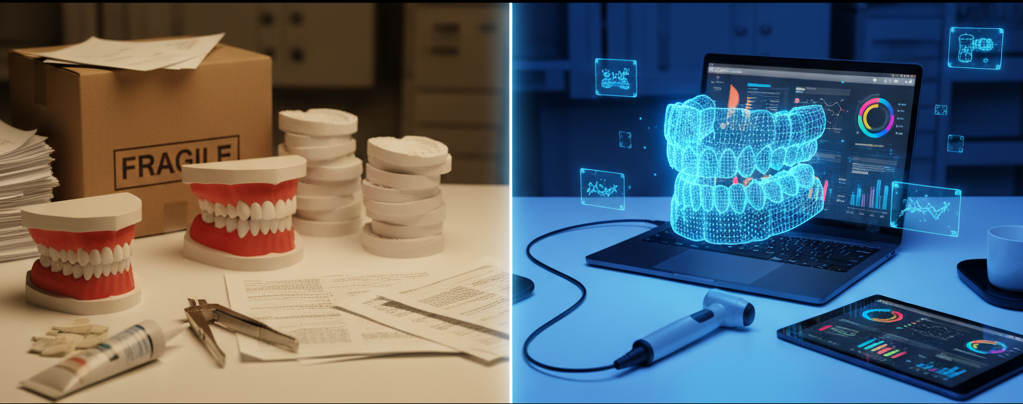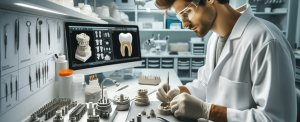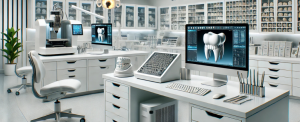Despite the technological leaps that have transformed dentistry in the last decade, a silent debate still exists in many clinics: Physical model or STL file?
Digitalization isn’t just a trend; it’s an imperative for efficiency and precision. However, many practices continue to use the traditional method of sending physical models (impressions or gypsum models) to their labs or dental design services. This familiar process introduces unnecessary risks, costs, and delays. It’s time to understand why migrating to a 100% digital workflow is the only logical decision to modernize your practice, reduce errors, and, most importantly, improve results for your patients.

The Showdown: Physical vs. STL
The STL (Stereolithography) file format has become the gold standard for digital dental design, capturing the 3D geometry of the patient’s mouth with unmatched accuracy. When compared to the physical model, its advantages are clear:
| Feature | Physical Model (Traditional) | STL File (Digital) |
| Accuracy | Susceptible to distortion from materials, transport, and humidity. | Maximum and consistent. Exact representation of the scanned geometry. |
| Delivery Time | Days, subject to courier and logistics. | Minutes or seconds. Instant delivery via the internet. |
| Shipping Cost | High (courier, packaging). | Zero (just the cost of your internet connection). |
| Traceability | Difficult to track; requires manual documentation. | Perfect traceability. Send time, reception, and processing are all logged. |
| Storage | Takes up physical space, requires filing. | Digital storage (in the cloud or hard drive), easy access and backup. |
| Risk of Loss/Damage | High during transport or handling. | None (the original file always stays in the clinic). |
| Processing Time | Added time for scanning at the lab, if applicable. | The lab/designer can start working immediately. |
Minimum requirements for a perfect STL submission
The power of the digital workflow lies in its precision. However, an incorrect STL file can be as problematic as a poor physical model. To ensure efficient online dental design service with WeCad4you, your file must adhere to these basic guidelines:
- No “Holes” or Noise: The file should not have perforations (holes) or “noise” or artifacts (floating points) that might confuse the designer. A quick review in your scanning software is crucial.
- Complete and clear scan: The file must show the entire relevant arch (or hemi-arch), including occlusal contacts and the areas of interest (e.g., the preparation margin line).
- Structure identification: If relevant (e.g., for implants or bridges), scan bodies or any reference structures must be clearly scanned.
- Separate files: Always submit the upper and lower arch scans in separate STL files.
- Correct Occlusion: The submission must include a third file, the bite registration, which should be correctly articulated and without shifts, or alternatively, the two main files must be pre-articulated by the scanning software.
Step-by-Step guide to migrating to a digital workflow
The transition doesn’t have to be complicated. Implementing digitalization in your dental practice is a process you can start today:
1. Acquire an Intraoral Scanner
This is the foundational investment. An intraoral scanner captures the patient’s mouth data quickly and accurately, instantly generating the dental STL files ready for submission.
2. Standardize the Flow
Define an internal protocol. For example:
Step 3: Quick review of the files to ensure no holes or artifacts are present.
Step 1: Complete scan of both arches and bite registration.
Step 2: Export the three files (Upper.stl, Lower.stl, Occlusion.stl).
3. Integrate with Your Design Service
Establish a direct connection with WeCad4you. Most online dental design services offer secure platforms for direct file upload. This ensures complete traceability and immediate confirmation that your case has been received.
4. Continuous training
Ensure your entire team is comfortable with the scanner and the export software. An hour of training can save days of delays and rework due to scanning errors.
By eliminating the logistics of the physical model, you save valuable time, remove the risks of damage or loss, and, above all, ensure the design work begins with maximum fidelity to your patient’s reality. The future of dentistry is digital, and the STL format is its language.
Ready to digitize your design workflow?Submit your first STL file to WeCad4you today and experience the difference in turnaround time, accuracy, and quality of our dental design service.



